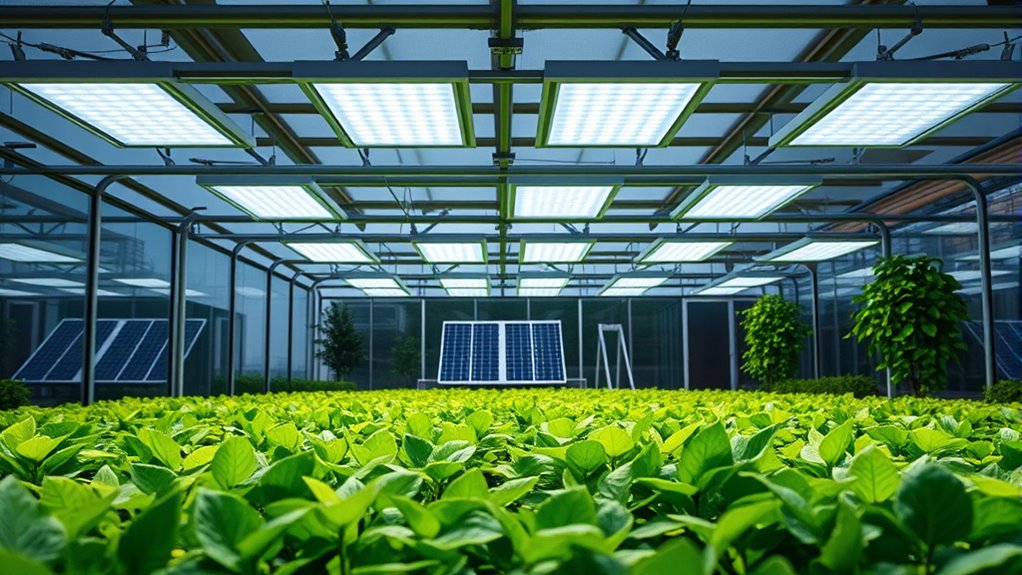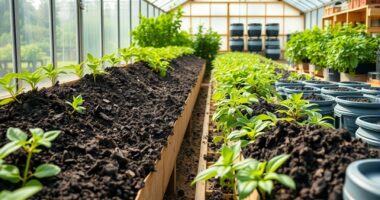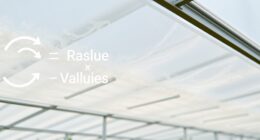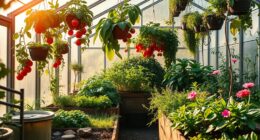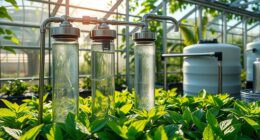To lower the carbon footprint of your greenhouse lighting, switch to energy-efficient LED fixtures that target plant needs and produce less heat. Combine this with renewable energy sources like solar or wind to power your operations sustainably. These upgrades not only reduce energy consumption but also cut greenhouse gas emissions in the long run. Keep exploring to discover more practical strategies that can boost your eco-friendly practices and save costs.
Key Takeaways
- Switch to energy-efficient LED grow lights to reduce electricity consumption and greenhouse gas emissions.
- Adopt renewable energy sources like solar or wind power to supply clean, sustainable electricity for lighting.
- Install smart lighting controls to optimize usage and minimize unnecessary energy waste.
- Implement sustainable practices and upgrade existing fixtures to environmentally friendly, low-impact options.
- Take advantage of financial incentives and rebates for renewable energy and energy-efficient lighting upgrades.
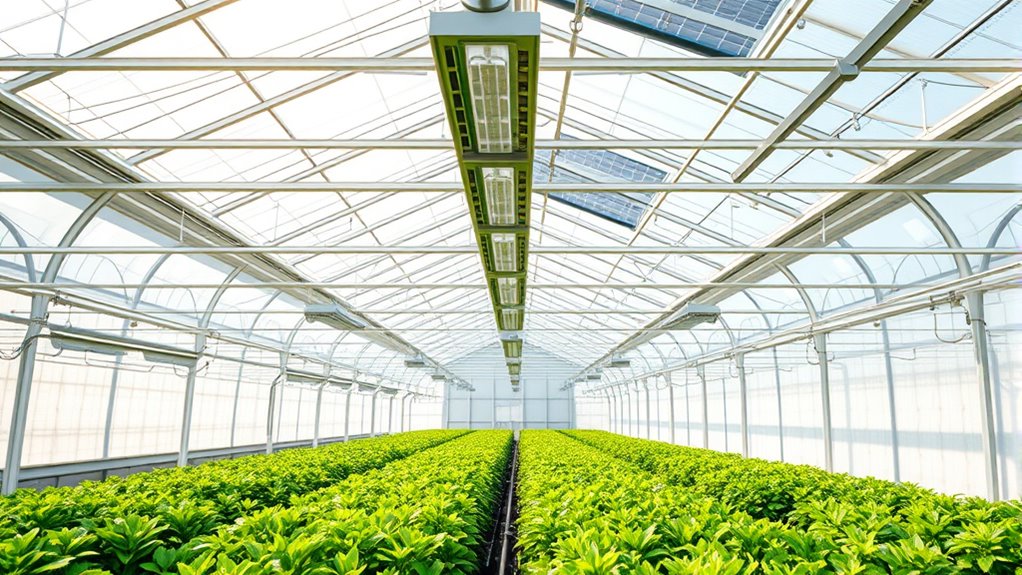
Have you ever wondered how greenhouse lighting impacts your environmental footprint? It’s a vital question, especially as you look for ways to make your operation more sustainable. The good news is that you can substantially reduce your greenhouse’s carbon emissions by focusing on how you power and light your space. One of the most effective strategies is embracing renewable energy adoption. By shifting from fossil fuels to solar, wind, or other renewable sources, you cut down on greenhouse gas emissions associated with electricity production. Installing solar panels or wind turbines not only makes your energy supply cleaner but also offers long-term savings and energy independence. Pairing renewable energy with energy-efficient fixtures creates a powerful combination that minimizes your environmental impact.
Using energy-efficient fixtures in your greenhouse is a straightforward yet impactful step. Modern LED grow lights consume far less electricity than traditional incandescent or halogen bulbs while providing the same, if not better, light quality for plant growth. LEDs are designed to deliver targeted, customizable light spectrums, ensuring your plants get what they need without wasting energy. This precision reduces overall power consumption, lowering your carbon footprint. Furthermore, energy-efficient fixtures tend to generate less heat, which can decrease your reliance on cooling systems, further reducing your energy use. When you choose LED and other energy-efficient lighting options, you’re not only saving on electricity costs but also contributing to a healthier planet.
Using LED grow lights reduces energy use and heat, supporting sustainable, cost-effective greenhouse operations.
Implementing these changes does require some upfront investment, but the long-term benefits are substantial. As you transition to renewable energy sources and upgrade to energy-efficient fixtures, you’ll notice a reduction in your greenhouse’s overall emissions. This shift helps combat climate change and aligns your operation with sustainable agriculture practices. Additionally, many regions offer incentives or rebates for adopting renewable energy systems and energy-efficient equipment, making these upgrades more accessible. Over time, these investments pay for themselves through lower utility bills and a reduced carbon footprint, reinforcing your commitment to environmental responsibility.
Incorporating renewable energy and energy-efficient fixtures isn’t just good for the planet; it’s smart business. Consumers are increasingly drawn to sustainable practices, and your efforts can serve as a powerful marketing tool. By lowering your greenhouse’s carbon footprint, you demonstrate leadership in environmental stewardship and contribute to a more sustainable future. Leveraging high-efficiency projectors can provide optimal lighting solutions that further reduce energy consumption. With thoughtful planning and commitment, you can transform your greenhouse into a model of eco-friendly innovation, making a meaningful difference in reducing greenhouse gases and protecting our planet.
Frequently Asked Questions
How Does Greenhouse Lighting Impact Local Ecosystems?
Greenhouse lighting can negatively impact local ecosystems by increasing pollution impact and causing habitat disruption. When you use excessive or poorly managed lighting, it may disturb nocturnal wildlife, interfere with natural behaviors, and contribute to light pollution. This disrupts habitats, especially for species sensitive to light changes. To minimize these effects, you should choose energy-efficient lighting and control its use, helping protect local ecosystems while maintaining plant growth.
What Are the Economic Benefits of Reducing Lighting Carbon Footprints?
Reducing your greenhouse lighting’s carbon footprint can lead to significant cost savings on energy bills. By adopting energy-efficient lighting systems, you’ll see quicker investment returns through lower operational costs. Plus, demonstrating your commitment to sustainability can boost your reputation, attracting eco-conscious customers and partners. Over time, these economic benefits add up, making it a smart financial move that supports long-term profitability and environmental responsibility.
Can Renewable Energy Fully Power Greenhouse Lighting Systems?
Like a mighty river fed by countless streams, renewable energy can fully power greenhouse lighting with enough renewable capacity and strategic energy storage. You harness the sun and wind, storing surplus energy for cloudy days and still nights. While technological advancements make this increasingly feasible, it requires careful planning. When well-implemented, your greenhouse becomes a beacon of sustainability, shining brightly without draining the planet’s resources.
How Does Lighting Efficiency Vary Across Different Greenhouse Crop Types?
You’ll find that lighting efficiency varies considerably across crop types due to crop-specific lighting needs and spectral efficiency. For example, leafy greens often require blue and red light, maximizing spectral efficiency for rapid growth, while flowering plants benefit from broader spectra. Understanding these differences helps you optimize your greenhouse lighting, reducing energy use and improving crop yields, all while lowering the carbon footprint of your greenhouse operations.
What Innovations Are Emerging in Low-Carbon Greenhouse Lighting Technologies?
You’ll see LED innovation advancing rapidly, making greenhouse lighting more energy-efficient and eco-friendly. Smart controls are emerging to optimize light use, adjusting intensity and timing based on plant needs and environmental conditions. These technologies reduce energy consumption and carbon emissions, helping you lower your greenhouse’s carbon footprint. By integrating cutting-edge LED solutions with smart controls, you can achieve sustainable growth while minimizing environmental impact.
Conclusion
By adopting energy-efficient lighting and smart controls, you can markedly reduce your greenhouse’s carbon footprint. Some experts believe that LED technology alone could cut global greenhouse emissions from horticultural lighting by up to 50%. While this may sound optimistic, recent studies support these claims, showing real-world energy savings. So, if you want to grow sustainably and help fight climate change, embracing innovative lighting solutions isn’t just smart—it’s necessary.
